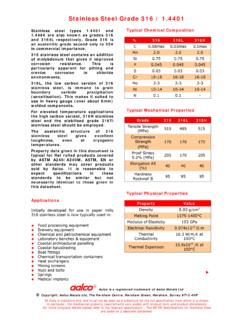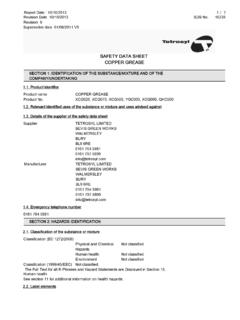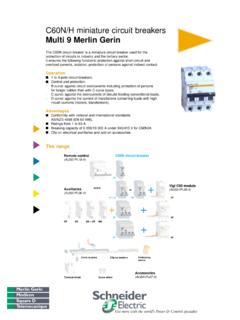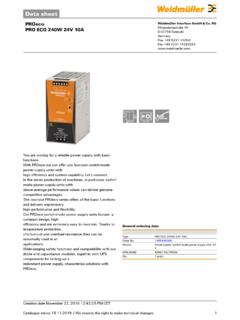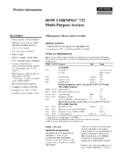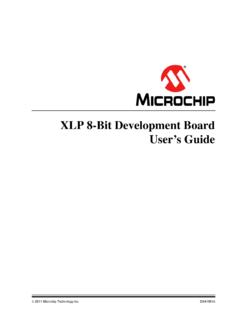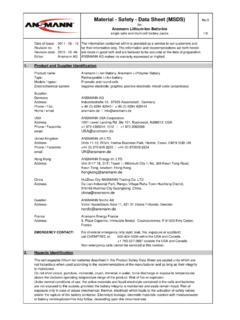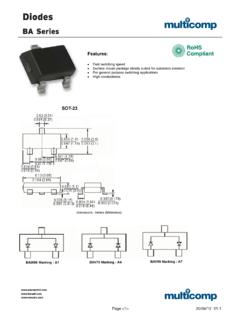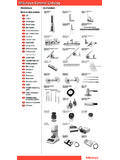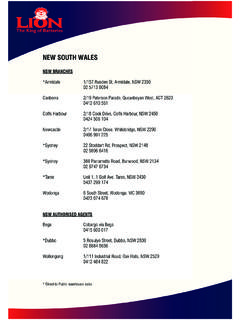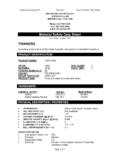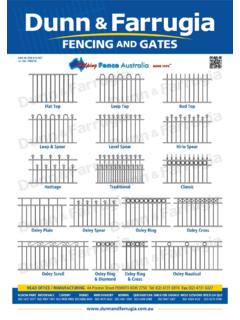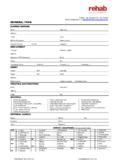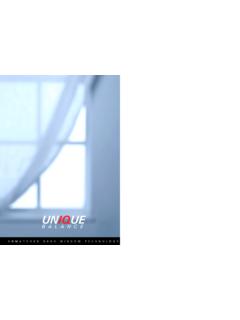Transcription of MATERIAL SAFETY DATA SHEET PENETRATING FLUID
1 Report Date : 24/11/2010 REVISION DATE: NOVEMBER 2010 MATERIAL SAFETY data SHEETPENETRATING FLUID1 IDENTIFICATION OF THE SUBSTANCE/PREPARATION AND OF THE COMPANY/UNDERTAKINGPRODUCT NAMEPENETRATING FLUIDPRODUCT [EDGT400]APPLICATIONL ubricantH K WENTWORTH PTY BOX 339 BROOKVALE, NSW 2100 AUSTRALIATEL: 02 9938 1566 FAX: 02 9938 1467 GENERAL MANAGEREMERGENCY TELEPHONETel: 029938 1566 between and ESTPROPER SHIPPING NAMEAEROSOLS2 HAZARDS IDENTIFICATIONRISK PHRASESR12 Extremely exposure may cause skin dryness or PHRASESA1 Pressurized container: protect from sunlight and do not expose to temperatures exceeding 50 C.
2 Do not pierce or burn, even after not spray on a naked flame or any incandescent out of the reach of container in a well-ventilated away from sources of ignition - No suitable only in well-ventilated ID 2 The above phrases are the risks associated with the productPHYSICAL AND CHEMICAL HAZARDSA erosol containers can explode when heated, due to excessive pressure build-up. When sprayed on a naked flame or any incandescent MATERIAL the aerosol vapours can be OF HAZARDOUS NATUREHAZARDOUS SUBSTANCE (According to criteria of NOHSC). DANGEROUS GOODS (According to ADG Code).
3 DG CLASSC lass 2: GasesPACKING GROUPN/AUN COMPOSITION/INFORMATION ON INGREDIENTS/51 Report Date : 24/11/2010 REVISION DATE: NOVEMBER 2010 PENETRATING FLUIDEC (NOHSC: 2011) KEROSINEXn; +;R1274-98-610-30%203-448-7 BUTANEF+;R12106-97-810-30%203-905-02-BUT OXYETHANOLXn;R20/21/22 Xi;R36/38111-76-21-5%The Full Text for all R-Phrases are Displayed in Section 16 COMPOSITION COMMENTSI ngredients not listed are classified as non-hazardous or at a concentration below reportable levels Ingredients are registered on AICS4 FIRST-AID MEASURESNOTES TO THE PHYSICIANT reat symptomaticallyINHALATIONMove the exposed person to fresh air at once.
4 Provide rest, warmth and fresh CONTACTWash the skin immediately with soap and water. Get medical attention if any discomfort CONTACTMake sure to remove any contact lenses from the eyes before rinsing. Promptly wash eyes with plenty of water while lifting the eye lids. Continue to rinse for at least 15 minutes. Get medical attention if any discomfort FIRE-FIGHTING MEASURESEXTINGUISHING MEDIAUse: Powder. Dry chemicals, sand, dolomite etc. Water spray, fog or FIRE FIGHTING PROCEDURESC ontainers close to fire should be removed or cooled with water.
5 Use water to keep fire exposed containers cool and disperse FIRE & EXPLOSION HAZARDSA erosol cans may explode in a ACCIDENTAL RELEASE MEASURESSPILL CLEAN UP METHODSE xtinguish all ignition sources. Avoid sparks, flames, heat and smoking. HANDLING AND STORAGEUSAGE PRECAUTIONSKeep away from heat, sparks and open flame. Avoid spilling, skin and eye contact. Ventilate well, avoid breathing vapours. Use approved respirator if air contamination is above accepted PRECAUTIONSA erosol cans: Must not be exposed to direct sunlight or temperatures above 50 EXPOSURE CONTROLS/PERSONAL PROTECTIONStdSTEL - 15 minTWA - 8 hrsNameNotes25 ppm(Sk) mg/m3(Sk)ES- TWA50 ppm(Sk)242 mg/m3(Sk)2-BUTOXYETHANOL800 ppm1900 mg/m3ES- TWABUTANEA sphyxiatingAsphyxiatingPROPANE/52 Report Date : 24/11/2010 REVISION DATE.
6 NOVEMBER 2010 PENETRATING FLUIDENGINEERING MEASURESAll handling to take place in well-ventilated EQUIPMENTNo specific recommendation made, but respiratory protection must be used if the general level exceeds the recommended occupational exposure PROTECTIONUse suitable protective gloves if risk of skin contact. The most suitable glove must be chosen in consultation with the gloves supplier, who can inform about the breakthrough time of the glove PROTECTIONWear approved, tight fitting SAFETY glasses where splashing is PROTECTIONWear appropriate clothing to prevent any possibility of liquid contact and repeated or prolonged vapour MEASURESDO NOT SMOKE IN WORK AREA!
7 Wash at the end of each work shift and before eating, smoking and using the toilet. When using do not eat, drink or PHYSICAL AND CHEMICAL PROPERTIESAPPEARANCEA erosol in waterBOILING POINT ( C)150 (302 F)RELATIVE @ 20 C (68 F)FLASH POINT ( C)<0 (32 F) CC (Closed cup).AUTO IGNITION TEMPERATURE ( C)>200 (392 F)10 STABILITY AND REACTIVITYSTABILITYS table under normal temperature TO AVOIDA void heat, flames and other sources of ignition. Avoid contact with: Strong oxidising agents. Strong alkalis. Strong mineral DECOMPOSITION PRODUCTSFire creates: Vapours/gases/fumes of: Carbon monoxide (CO).
8 Carbon dioxide (CO2).11 TOXICOLOGICAL INFORMATIONGENERAL INFORMATIONNo specific health warnings may cause drowsiness and CONTACTR epeated exposure may cause skin dryness or CONTACTMay cause temporary eye Dose 1 - LD 501480 mg/kg (oral rat)12 ECOLOGICAL INFORMATIONECOTOXICITYNot regarded as dangerous for the 50, 96 Hrs, FISH mg/l1700EC 50, 48 Hrs, DAPHNIA, mg/l>1000IC 50, 72 Hrs, ALGAE, mg/l50013 DISPOSAL CONSIDERATIONS/53 Report Date : 24/11/2010 REVISION DATE: NOVEMBER 2010 PENETRATING FLUIDDISPOSAL METHODSE mpty containers must not be burned because of explosion hazard.
9 Dispose of waste and residues in accordance with local authority TRANSPORT INFORMATIONPROPER SHIPPING NAMEAEROSOLSUDF Phrase 1 Class : Flammable gasesClass : Flammable gases1950UN CLASS 2: GasesDG CLASSN/APACKING GROUP(D)TUNNEL RESTRICTION LABEL NO. CLASSN/AIMDG PACK , S-UEMS1950UN NO. CLASSN/AAIR PACK REGULATORY INFORMATIONLABELLINGE xtremely FlammableRISK PHRASESR12 Extremely exposure may cause skin dryness or PHRASESA1 Pressurized container: protect from sunlight and do not expose to temperatures exceeding 50 C. Do not pierce or burn.
10 Even after not spray on a naked flame or any incandescent out of the reach of container in a well-ventilated away from sources of ignition - No suitable only in well-ventilated SCHEDULE NUMBERNONENATIONAL REGULATIONS AND REFERENCESN ational Model Regulations for the Control of Workplace Hazardous Code of Practice for the Control of Workplace Hazardous Code of Practice for the Labelling of Workplace Code of Practice for the Preparation of MATERIAL SAFETY data Criteria for Classifying Hazardous Standards for Atmospheric Contaminants in the Occupational Dangerous Goods Code.
